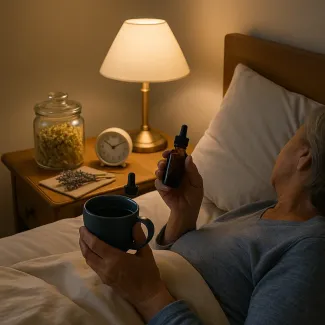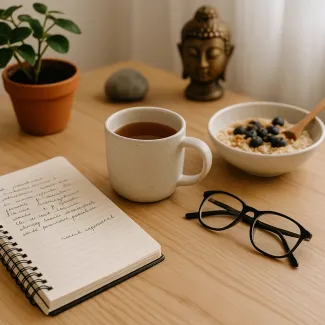
Natural techniques to promote deeper sleep after 60
Understanding the unique sleep challenges of people over 60
As we age, sleep patterns often change, and many individuals over 60 experience difficulty falling asleep, frequent night awakenings, or light sleep that doesn’t feel restorative. These changes can stem from various factors, including hormonal shifts, medical conditions, reduced melatonin production, and even lifestyle habits accumulated over the years. Recognizing these natural changes is the first step toward finding effective solutions that bring back restful nights.
How lifestyle adjustments can improve sleep quality
Embracing small daily habits can significantly impact the quality of sleep in your 60s. For instance, establishing a consistent bedtime routine helps signal your body that it’s time to wind down. This can include activities such as gentle stretching, reading a calming book, or listening to soft music. Limiting screen exposure at least one hour before bed reduces the impact of blue light, which is known to interfere with melatonin production.
The role of nutrition in supporting restful nights
Foods that encourage natural sleep
Certain foods contain compounds that may promote better sleep. Bananas, almonds, and oatmeal are rich in magnesium and tryptophan, nutrients that help the body produce serotonin and melatonin. Including these foods in your evening meal or as a light snack can create favorable conditions for falling asleep.
Evening eating habits to avoid
Late-night consumption of caffeine, alcohol, or heavy meals can disrupt sleep cycles. It’s recommended to finish dinner at least three hours before bedtime, allowing digestion to progress without interfering with sleep onset. Opting for light, easily digestible meals in the evening supports smoother transitions to sleep.
Creating a sleep-friendly bedroom environment
Ideal room temperature and lighting
A cool, dark, and quiet bedroom promotes deeper sleep. Experts suggest keeping the room temperature around 18–20°C (64–68°F). Using blackout curtains and white noise machines can block disturbances and enhance the sense of calm needed for uninterrupted sleep.
Choosing the right mattress and pillows
The comfort of your mattress and pillows directly affects your ability to sleep soundly. Look for options that provide adequate support for joints and the spine. Memory foam mattresses or adjustable beds can be particularly beneficial for people over 60 who experience joint stiffness or back pain.
Gentle physical activities that help with sleep
Evening stretching and yoga
Engaging in gentle stretching routines or restorative yoga in the evening can help release muscle tension and promote a state of relaxation. Practices such as deep breathing exercises during these routines encourage the body’s parasympathetic nervous system, helping you ease into sleep naturally.
The benefits of daily walks
A simple daily walk, preferably in the morning or early afternoon, provides exposure to natural light, which helps regulate your circadian rhythm. It also contributes to overall physical well-being and reduces feelings of restlessness at night.
Mindfulness and relaxation techniques
Meditation for better sleep
Practicing mindfulness meditation before bedtime helps calm a busy mind and reduces stress levels. Techniques such as focusing on the breath or visualizing a peaceful scene can prevent racing thoughts that often delay sleep.
Progressive muscle relaxation
Progressive muscle relaxation involves tensing and releasing muscle groups in sequence, starting from your toes up to your head. This method increases awareness of body tension and promotes full-body relaxation, making it easier to drift into sleep.
Managing common health-related sleep disruptors
Addressing sleep apnea
Sleep apnea is more prevalent after 60 and can severely impact sleep quality. Recognizing symptoms like loud snoring, gasping for air, or morning headaches is important. Seeking medical advice for diagnosis and treatment options, such as CPAP therapy, can restore normal sleep patterns.
Handling restless leg syndrome
Many individuals over 60 experience restless leg syndrome, leading to unpleasant sensations and the urge to move the legs at night. Incorporating magnesium-rich foods, gentle massages, and leg stretches before bedtime may help reduce these symptoms naturally.
The importance of consistent sleep schedules
Why regular sleep-wake times matter
Keeping a regular sleep schedule helps synchronize the body’s internal clock, or circadian rhythm. Going to bed and waking up at the same time each day, even on weekends, reinforces natural sleep patterns and supports refreshing mornings.
Limiting daytime naps
While short naps can provide a boost, long daytime naps may interfere with nighttime sleep. If needed, limit naps to 20–30 minutes early in the afternoon to avoid disrupting your normal sleep cycle.
Herbal and natural remedies to consider
Chamomile and valerian root
Herbal teas like chamomile or valerian root infusions are known for their mild sedative effects. Sipping a warm cup of these teas before bed may help prepare the mind and body for rest.
Aromatherapy with lavender
Using lavender essential oil in a diffuser or as a pillow spray can create a soothing atmosphere that encourages relaxation. Studies suggest that lavender aromatherapy may improve both sleep duration and quality.
Reducing nighttime anxiety
Journaling before bed
Writing down worries or to-do lists before bed can help clear the mind and reduce pre-sleep anxiety. This practice may prevent thoughts from spiraling as you try to fall asleep, promoting a more peaceful transition to rest.
Limiting exposure to negative news
Avoiding stressful news or conversations in the evening supports a calm mindset. Instead, choose uplifting or neutral activities, such as light reading or listening to soothing music.
Hydration and sleep
Finding the right balance
Staying hydrated during the day is essential for overall health, but excessive fluid intake late in the evening may lead to frequent bathroom trips that disrupt sleep. Aim to drink most of your fluids earlier in the day and limit intake about two hours before bedtime.
Avoiding dehydrating substances
Reducing consumption of alcohol and caffeinated beverages supports better hydration and promotes uninterrupted sleep. Both substances can interfere with the body’s ability to achieve deep, restorative sleep stages.
Building a supportive bedtime routine
The power of consistency
A consistent bedtime routine acts as a signal to the body that sleep is approaching. Whether it includes brushing teeth, light stretching, or listening to calming music, repeating the same steps nightly strengthens the association with winding down.
Activities to avoid
Stimulating activities such as intense exercise, exciting TV shows, or late-night work can make it harder to fall asleep. Creating a wind-down period of at least 30–60 minutes helps the body transition into a restful state.
The connection between sunlight and sleep
Morning light exposure
Exposure to morning sunlight helps regulate melatonin production and aligns the circadian rhythm with the natural day-night cycle. Spending at least 15–30 minutes outside shortly after waking can improve the ease of falling asleep at night.
Evening light exposure
As the evening approaches, reducing artificial light exposure, especially blue light from devices, supports the body’s natural preparation for sleep. Dim lighting in the evening creates an environment conducive to rest.
When to seek professional help
Recognizing chronic sleep issues
If sleep difficulties persist for several weeks despite lifestyle changes, it may be time to consult a healthcare provider. Chronic insomnia, severe daytime fatigue, or signs of sleep disorders often require professional evaluation.
Exploring treatment options
Treatments may include cognitive behavioral therapy for insomnia (CBT-I), prescribed medications, or recommendations for specialized sleep studies to identify underlying conditions. Seeking help ensures a tailored plan to restore healthy sleep patterns.
